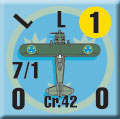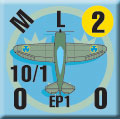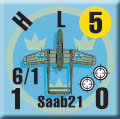| Sea of Iron:
Sweden’s Fighter Planes
By Mike Bennighof, Ph.D.
April 2020
 We usually market Second World War at Sea as game about ships, but it’s also filled with airplanes. And in Sea of Iron, the airplanes are even more important than in other series games. They aren’t any more powerful here, but the Baltic Sea is very small. Every bit of it is within range of an airfield, with the most important parts within easy flying distance of many large airfields. We usually market Second World War at Sea as game about ships, but it’s also filled with airplanes. And in Sea of Iron, the airplanes are even more important than in other series games. They aren’t any more powerful here, but the Baltic Sea is very small. Every bit of it is within range of an airfield, with the most important parts within easy flying distance of many large airfields.
Given that reality, when Sweden moved to strengthen her defenses in the late 1930’s (really only starting in 1939) aircraft formed a major part of the effort. The Swedish Air Force became a large and reasonably modern force; the Swedes held hard currency and were willing to spend it, but were limited by a tight world market for high-performance warplanes.
Here’s a look at the fighter planes of the Swedish Air Force of Sea of Iron.
  
Sweden possessed no modern fighters when the 1939 shopping spree began, and only a handful of obsolescent ones. The British-made Gloster Gladiator was considered a modern fighter when the Swedes purchased it in 1939, but Royal Air Force squadrons were already receiving more modern planes even as new Gladiators came off the assembly line. The Swedes bought 55 of the biplane fighters, passing some along to Finland during the Winter War and sending a squadron of their own to fight alongside the Finns (decked out in Finnish colors).
With few nations willing to part with modern aircraft, the Swedes turned to Italy. Desperate for hard currency, the Italians were willing to sell front-line planes, and the Swedes bought 72 Cr.42 biplane fighters despite some misgivings that the age of the biplane had passed. For Swedish service, Fiat, the manufacturer, equipped the planes with optional ski landing gear and some added armor in the cockpit. While Italian pilots loved their Falchi, Swedish fliers did not, and accidents or breakdown had claimed almost half of the Swedish allotment within just a few years’ service – indicating that Fiat may well have unloaded defective planes on the Swedes.
Alexander de Seversky, founder of the aircraft manufacturer that bore his name, undertook a barnstorming tour of Europe in his firm’s P35 fighter, hoping to increase foreign sales. Sweden signed on for 120 copies of a version with a more powerful engine, designated EP-1 by the Swedes. The first lot of sixty was delivered in 1940, but the U.S. War Department seized the second consignment and designated the plane the P35A. In Swedish service, the EP-1 remained a front-line fighter until 1945 despite its obsolescence.
Denied all of their EP-1 fighters, the Swedes again turned to Italy. Reggiane had begun manufacture of a knockoff version, the Re2000, and the Swedes ordered 60 of them to replace the lost Seversky planes. The Re2000 proved a little more combat-worthy than the EP-1, but shared the mechanical troubles of the Fiat planes in the Swedish climate. As with the Cr.42, almost half of Sweden’s Re2000 fighters were no longer serviceable when they were replaced by much more capable planes in 1945.
At the same time the Swedes ordered the P35A, they also bought 144 of the new P66 Vultee Vanguard, a plane still on the drawing board when ordered in February 1940. When production deliveries began in September 1941, the U.S. government confiscated the planes, later shipping most of them to Nationalist China.
  
Denied their modern planes, the Swedes became determined to build their own. With Saab’s production lines working overtime building bombers, a new firm was established to build Sweden’s first domestic fighter. The FFVS22 carried the same Pratt&Whitney engine as the P35A (built in Sweden without benefit of a license, an apparent retaliation for the Americans’ seizure of Swedish airplanes). The plane performed well considering its origins, and remained in service until 1952 even as high-performance aircraft finally became available.
Not until the end of the war did the Swedes obtain better fighters, and then they received some very fine planes. The Swedish-designed and -built Saab 21 was a highly unusual plane, a twin-boom pusher aircraft built around a licensed copy of the powerful Daimler-Benz 605 engine (while the Swedes disdained paying license fees to the Americans, they paid them to the Nazis). The Saab 21 proved very fast and carried a powerful armament of a 20mm cannon and four 13mm machine guns (a Bofors version of the Browning .50 caliber). With the propeller mounted behind the cockpit, the nose was free to be packed with weaponry. The Saab 21 entered service in 1945 but only remained a front-line plane for a few years, giving way to new jets by the end of the 1950’s. A much faster jet-powered version followed in 1947.
A handful of P-51 Mustangs landed in Sweden during the course of the war and were taken into the Swedish Air Force. Impressed by the plane, the Swedes bought 50 of them just before the war ended and 90 more just after. The Mustang far outclassed anything in the Swedish inventory, and also outclassed anything in the Soviet inventory.
Despite holding a temporary technological edge over their potential opponents, the Swedes wanted jets. Saab had worked on jet engines during the war, producing one of the world’s early jet fighters with the Saab 21 jet version. Not satisfied with the Saab jet, which could not match the piston-engined Mustang’s performance, the Swedes bought 70 DeHavilland Vampire jet fighters in 1945 and 310 more over the next several years. The Vampire had replaced all other Swedish fighters by the early 1950’s, and remained the sole Swedish fighter plane until the Saab “Flying Barrel” replaced it in the middle of the decade, but that’s a plane for another game.
Click here to order Sea of Iron right now!
Sign up for our newsletter right here. Your info will never be sold or transferred; we'll just use it to update you on new games and new offers.
Mike Bennighof is president of Avalanche Press and holds a doctorate in history from Emory University. A Fulbright Scholar and NASA Journalist in Space finalist, he has published over 100 books, games and articles on historical subjects.
He lives in Birmingham, Alabama with his wife, three children and his dog, Leopold.
|
